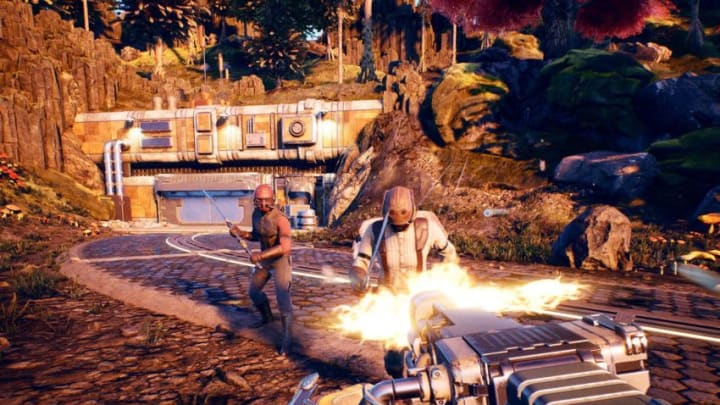The Outer Worlds takes the Fallout formula into the wilds of a somewhat tamed outer space.
Developer: Obsidian Entertainment
Publisher: Private Division
Platforms: PS4 (version reviewed), Xbox One, PC, Nintendo Switch (TBA)
Release Date: October 25th
Quick question, how many people remember the short-lived 2002-2003 series Firefly? Before he became one of the most famous directors in the world for making two extremely successful movies starring Marvel’s Avengers, Joss Whedon was mostly a TV guy, known for cult hits like Buffy the Vampire Slayer. Firefly was best described as an outer space western where a lovable band of outlaws tried to survive in the outer rim of space pulling mostly illegal jobs while evading a seemingly omnipotent corporation intent on tracking them down. It was a great show that Fox never gave a chance to get going, but that’s a story for another time.
I’m sure many more of you are familiar with Fallout, the insanely popular video game series from Bethesda. Sure, it’s had some rocky recent history but generally speaking the gameplay, apocalyptic setting and dark humor have been a hit with gamers for a long time.
Combine these two flavors and you get a good idea of what you are getting with Obsidian Entertainment’s The Outer Worlds, their last multiplatform release before all of the future games by them are exclusively developed for Microsoft platforms. Microsoft announces it had acquired Obsidian — the studio also responsible for Fallout: New Vegas, Pillars of Eternity and more beloved titles — back in November.

The gameplay in The Outer Worlds is pretty much directly lifted from Fallout with some tweaks here and there; but, if you’ve played pretty much any Bethesda RPG, you’ll be familiar with The Outer Worlds from the onset. The graphical style is the same, though much brighter and more colorful since you are visiting various planets instead of a dead, post-apocalyptic wasteland. In fact, this allows for a much more adventurous atmosphere. While there is a vast corporation oppressing everyone, it’s still more varied and light, and the setting allows for more wild stuff than you’d see in a game just set on an Earth devastated by nuclear fallout. There’s also a noticeable difference in NPC faces in The Outer Worlds; they just have more detail and are more expressive than in similar games of this style, which helps a lot.
The gunplay is similar though it does not have the “V.A.T.S.” feature that essentially turns Fallout into a turn-based RPG. You do have a limited ability to slow down time but it’s very different from the V.A.T.S. system.
In the Fallout games, I found V.A.T.S. to be necessary as the standard combat in that series could be extremely janky and it was very hard to aim. In The Outer Worlds, guns are more accurate and its easier to hit enemies. So while you can slow downtime, it’s not nearly as necessary.

Additionally, there are a couple of systems that seemed slightly under-developed. For one, there’s a feature where if you get damaged by something enough, the game offers you a trade: you can suffer an additional penalty for this damage, but you’ll get a reward. What is that reward? One lousy perk point. You get perk points every other level. While some are extremely useful, unless for some reason you are looking to get as many perks as possible, this is totally unnecessary. It needed a better reward for the additional risk.
The other undercooked feature is the “factions,” as it seems like unless you just go randomly killing faction members or stealing everything in sight (totally unnecessary as loot is plentiful), it’s super easy to gain favor with most, if not all factions. In fact, it’s pretty hard to get them to turn on you through quests or bg decisions. I completely screwed over one faction early on, and I still had a very favorable rating with them throughout the remainder of the game — and not much chance to anger them further unless I really really wanted to.
So if you are tired of the Bethesda formula, what in The Outer Worlds might appeal to you? For one, compared to the massive RPGs of today, it’s actually pretty short. Though I certainly missed out on some things (there were two party members I never seemed to encounter), I managed to do quite a few side quests and finish the main storyline in around 30 hours — so it isn’t the huge undertaking that will eat up weeks or months of your life.

Where The Outer Worlds really steps up though is an area Obisidian Entertainment has a knack for, and that’s in the writing and characters. I never found many Bethesda companions or most NPCs to be particularly fun or memorable, but I had a blast interacting with the people that inhabit The Outer Worlds. They are well-developed, have interesting backstories and can be incredibly funny. In fact, there is a ton of well-written humor in The Outer Worlds and it’s on display in the dialogue options, in-game lore, sign gags and even loading screens. That kept me going way more than the somewhat too-familiar gameplay.
Though I had spent hundreds of hours on games like Morrowind, Oblivion, and Fallout 3, when Skyrim and Fallout 4 rolled around, I just felt that maybe I was tired of this style of gameplay. Turns out, all I needed was for someone to take it into outer space, inject with a healthy dose of Firefly flavor and give it some really sharp writing to prove me wrong. I’m not sure that will work for everyone, but it sure worked for me.
A copy of this game was provided to App Trigger for the purpose of this review. All scores are ranked out of 10, with .5 increments. Click here to learn more about our Review Policy.
